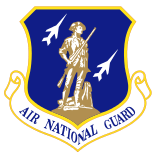188th Rescue Squadron
| 188th Rescue Squadron | |
|---|---|
|
188th Fighter Squadron – General Dynamics F-16C Block 30F Fighting Falcon 87-0243 | |
| Active | 1943 - Present |
| Country |
|
| Allegiance |
|
| Branch |
|
| Type | Squadron |
| Role | Aircrew Training |
| Part of | New Mexico Air National Guard |
| Garrison/HQ | Kirtland Air Force Base, Albuquerque, New Mexico |
| Nickname(s) |
"Enchilada Air Force" "The Tacos" |
| Tail Code | Yellow Tail Stripe, "Roadrunner"; In small letters on the base of the tail are the words "The Tacos" |
| Engagements |
World War II Operation Iraqi Freedom |
| Insignia | |
| 188th Fighter Squadron emblem |
|
The 188th Rescue Squadron (188 RQS) is unit of the New Mexico Air National Guard. It is assigned to the 150th Special Operations Wing (150 SOW) located at Kirtland Air Force Base, Albuquerque, New Mexico.
History
World War II
Established as the 621st Bombardment Squadron (Dive) on 25 January 1943, converted from A-24 Banshee (Dauntless) dive bombers to P-39 Airacobra fighters in August and was redesignated the 507th Fighter-Bomber Squadron. After training was completed at Myrtle Beach AAF, South Carolina, deployed to the European Theater of Operations (ETO), assigned to IX Fighter Command in England where it was assigned P-47 Thunderbolts and was again redesignated as the 508th Fighter Squadron.
Began operations by bombing and strafing targets in France. The squadrons provided top cover for landings in Normandy on 6 and 7 June 1944. On 6 July the squadron moved across the Channel to its Advanced Landing Ground at Chippelle (ALG A-5), France. Operated in close support of ground troops until the end of the war, supporting the Allied breakthrough at Saint-Lô in July 1944, the drive through Holland in September 1944, Allied operations during the Battle of the Bulge (December 1944 – January 1945), and the establishment of the Remagen bridgehead and the subsequent crossing of the Rhine in March 1945.
After the German Capitulation, became part of the occupying United States Air Forces in Europe though the summer of 1945. Returned to the United States and was demobilized during the fall, inactivated in early November.
New Mexico Air National Guard

The wartime 507th Fighter Squadron was re-designated and re-activated on 24 May 1946 as the 188th Fighter Squadron, and was allotted to the New Mexico Air National Guard. It was organized at Kirtland Field, New Mexico and was extended federal recognition on 7 July 1947 by the National Guard Bureau. The 188th Fighter Squadron was bestowed the lineage, history, honors, and colors of the 507th Fighter Squadron and its predecessor units. The squadron was equipped with F-51D Mustangs and a few B-26 Invaders, being assigned to Fourth Air Force, Continental Air Command. The 188th's post-war mission of the New Mexico Air National Guard was the air defense of the state.
Korean War federalization
On 1 February 1951, the 188th was federalized and brought to active duty for the Korean War. A total of 54 officers and 400 airmen were assigned to Long Beach Municipal Airport, California, as part of Air Defense Command. Its mission became the air defense of Southern California.
Most unit members were then transferred to active-duty Air Force units and deployed to Japan and South Korea. First Lieutenants Robert Lucas and Joseph Murray were killed while flying close air support missions in Korea. Captain Francis Williams and First Lieutenant Robert Sands were each credited with three MiG-15 kills. The unit was released from federal active duty in November 1952.
Cold War
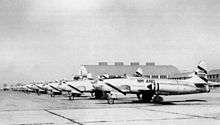
After the Korean War ended, the 188th was re-equipped with F-80C Shooting Star jet aircraft, and became part of Air Defense Command, being assigned to the Western Air Defense Force.
On 1 July 1957, the 188th was authorized to expand to a group level, and the 150th Fighter-Interceptor Group was established by the National Guard Bureau. The 188th FIS becoming the group's flying squadron. Other squadrons assigned into the group were the 150th Headquarters, 150th Material Squadron (Maintenance), 150th Combat Support Squadron, and the 150th USAF Dispensary. Also, the 188th Fighter Interceptor Squadron assumed 24-hour Air Defense alert status at Kirtland Air Force Base. In April 1958, the first Air National Guard unit to receive the North American F-100A Super Sabre was the 188th TFS of the New Mexico ANG, which received these planes in April 1958. This conversion raised unit strength to 956 officers and airmen.
In April 1961, an aircraft malfunction caused an AIM-9 Sidewinder air-to-air missile to launch and shoot down a B-52B Stratofortress bomber near Grants, New Mexico. The B-52B (AF Ser. No. 53-0380, aircraft nickname "Ciudad Juarez") from the 95th Bomb Wing took off from Biggs Air Force Base, at El Paso, Texas on a practice mission. During an intercept by two New Mexico ANG F-100As, an AIM-9B shook loose and impacted one of the engine pods on the left wing, taking the B-52's left wing off in the subsequent explosion. Three B-52 crewmembers died; the F-100 pilot was absolved of any blame.[1] In the fall of 1962, the Cuban missile crisis put the 150th on an alert status that lasted for 90 days.
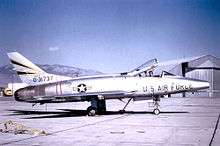
In 1964, the F-100As were retired and the 188th received newer F-100C and twin-seat F-100F Super Sabre trainers; being reassigned from Aerospace Defense Command to Tactical Air Command.
In January 1968, the group was activated as a result of the Pueblo Crisis, and in June of that year the 188th Tactical Fighter Squadron and approximately 250 maintenance and support personnel were deployed to Tuy Hoa Air Base, Republic of Vietnam. Remaining group members were assigned to various bases in South Korea. The unit flew over 6000 combat sorties in the F-100C Super Sabre and amassed over 630 medals and decorations before release from federal active duty in June 1969. Captain Michael Adams was killed in action and Major Bobby Neeld and First Lieutenant Mitchell Lane remain listed as missing in action. The unit received the AF Outstanding Unit Award with a bronze "V' for valor. After its Vietnam War deployment, the 188th was relieved from active duty and returned to New Mexico State Control on 4 June 1969.

In 1973, after the United States withdrew its forces from South Vietnam, the 188th TFS became the first Air National Guard squadron to receive A-7D Corsair II subsonic tactical close air support aircraft from Tactical Air Command units that were preparing to receive the new A-10 Thunderbolt II. Receiving its aircraft from the 354th TFW at Myrtle Beach AFB and the 355th TFW at Davis-Monthan AFB, Arizona. The aircraft had excellent accuracy with the aid of an automatic electronic navigation and weapons delivery system. Although designed primarily as a ground attack aircraft, it also had limited air-to-air combat capability.
In 1977, the unit participated in the "Coronet Ante" exercise, which was part of the NATO "Coldfire" exercise in Europe. The 150th TFG deployed nine A-7Ds to Gilze Rijen Air Base, The Netherlands, from 2 September through 27 September 1977. Close air support missions were flown over The Netherlands, France, the United Kingdom, Germany, Belgium, and the North Sea. In 1980, the 188th received the new twin-seat A-7K trainer.
In 1980, the 150th Tactical Fighter Group was first ANG to be assigned to the prestigious Rapid Deployment Joint Task Force (RDJTF); the first ANG unit to participate in Bright Star joint service exercises in Southwest Asia; the first ANG unit to receive the Low Altitude Night Attack modification to the A-7D; the first ANG unit to participate in a deployed bare base operational readiness inspection, and the first ANG unit to have a crew chief as a member of the Air Force Thunderbirds.
Additionally, the 150th TFG set an A-7D and first endurance record of 11 1/2 hours non-stop from Pease AFB, New Hampshire to Cairo West Air Base, Egypt. Over the years, the 150th received the following awards: (1) Spaatz Trophy in 1956, (2) Winston P. Wilson Trophy in 1980, (3) Air Force Outstanding Unit Awards in 1989 and February 1996, (4) Top A-7 Team at Gunsmoke in 1989 and 1991, (5) Distinguished Flying Unit Award in 1991, and (6) Outstanding ANG Unit in 1991.
The 150th Fighter Group was partially activated in support of Operation Desert Storm, although no A-7D aircraft were sent to Southwest Asia. On 11 December 1990, 44 members of the 150th Security Police Flight and other unit members were deployed to Saudi Arabia. All members returned home by May 1991.
Modern era
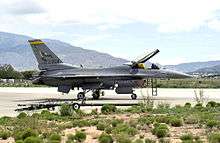
Early in the 1990s with the declared end of the Cold War and the continued decline in military budgets, the Air Force restructured to meet changes in strategic requirements, decreasing personnel, and a smaller infrastructure. The 169th adopted the new USAF "Objective Organization" in early 1992, with the word "tactical" being eliminated from its designation and becoming the 150th Fighter Group. Tactical Air Command was inactivated on 1 June, being replaced by the new Air Combat Command (ACC).
The 188th TFS flew A-7D's for twenty years before converting to the F-16 Fighting Falcon. On 11 May 1992 the 188th FS received their first Block 40 F-16C and their last A-7D left on 28 September 1992, being retired to Davis-Monthan AFB AMARC storage. With this event the A-7D was almost phased out completely as the 188th FS was one of the last Air National Guard units to fly the venerable aircraft.
However, instead of converting to older F-16A/B models, the squadron received relatively new block 40 aircraft. This type had the Low Altitude Night Targeting Infra Red Navigational system (LANTIRN) on board for advanced navigation and targeting by day and night. Again, the 188th was the first within the Air National Guard to have this capacity.
On 1 October 1995 ACC and the National Guard Board authorized the status of the 150th to be expanded to the Wing level, and the 188th Fighter Squadron became part of the new 150th Operations Group under the new 150th Fighter Wing.
150th Defense System Evaluation Flight
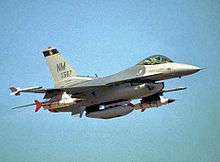
An out of the ordinary organizational setup was also at hand in the 188th FS. Within the squadron was another flight – being the 150th DSE (Defense System Evaluation) – which flew F-16C block 30 aircraft. It typically had about five on hand. Even during the time frame when the 188th FS was flying block 40's the DSE had F-16 block 30's. The 150th DSE provided fighter aircraft support to the US Army Air Defense Center and White Sands Missile Range.
Typically testing for the army and various navies around the world. With the USAF, the 150th DSE was selected to do all the flight tests for the F/A-22 Raptor before they leave the Marietta factory in Georgia. Tests usually involved avionics, radar systems and more. The squadron would deployed two F-16s to the Marietta factory adjacent to Dobbins Air Reserve Base, Atlanta, Georgia for a six-week period for each test. But for the most part any other tests were done over the White Sands Missile Range in New Mexico. The 150th DSE was disbanded in 2007 with many jets departing during the year prior.
Expeditionary Force deployments
In mid-1996, the Air Force, in response to budget cuts, and changing world situations, began experimenting with Air Expeditionary organizations. The Air Expeditionary Force (AEF) concept was developed that would mix Active-Duty, Reserve and Air National Guard elements into a combined force. Instead of entire permanent units deploying as "Provisional" as in the 1991 Gulf War, Expeditionary units are composed of "aviation packages" from several wings, including active-duty Air Force, the Air Force Reserve Command and the Air National Guard, would be married together to carry out the assigned deployment rotation.

In April 1998, the 188th Expeditionary Fighter Squadron (188 EFS) deployed 6 F-16s and support personnel to Al Jaber AB, Kuwait in support of Operation Southern Watch. Operation Southern Watch was an operation which was responsible for enforcing the United Nations mandated no-fly zone below the 32nd parallel in Iraq. This mission was initiated mainly to cover for attacks of Iraqi forces on the Iraqi Shi’ite Muslims. The 188th EFS returned to Kirtland in July 1998 and was inactivated.
The 188th EFS was again activated in March 2001, deploying to Incirlik AB, Turkey in support of Operation Northern Watch. Operation Northern Watch was a US European Command Combined Task Force (CTF) who was responsible for enforcing the United Nations mandated no-fly zone above the 36th parallel in Iraq. This mission was a successor to Operation Provide Comfort which also entailed support for the Iraqi Kurds. The deployed personnel and aircraft returned in June 2001 and the 188th EFS was again inactivated.
Global War on Terrorism
After the attacks of September 11, 2001, the 150th FW supported several deployments in support of Operation Noble Eagle to Atlantic City AGB, New Jersey and March ARB, California. Within hours of the terrorist attacks on New York and Washington, 150th FW pilots flew combat air patrol sorties over key resources in the western United States, and continued to do so for many months. To protect the local homeland, 150th Security Forces Squadron (SFS) personnel provided several months of security protection to the Albuquerque International Airport.
The 188th EFS has also been activated and the squadron has made several deployments worldwide in the F-16 to Singapore, Australia, Chile, and South Korea. In May 2004, the 188th EFS deployed its F-16s to Balad AB, Iraq, becoming the first U. S. Fighter squadron to be stationed at the base. In October 2007, the unit returned to Balad as part of a Rainbow deployment AEF 9/10 (Cycle 6) which included the 119th, 120th, 134th, 163rd, 186th and 188th EFS. The deployment cycle started in September and the 188th FS sent six aircraft with two spares that returned stateside immediately.
New Mission
Although rated a number 1 facility in the 2005 BRAC plan, the USAF decided to close down the 188th Fighter Squadron and convert Kirtland AFB from a fighter to a special operations base as part of the reduction of the USAF fighter fleet by 250 aircraft. The hope is that some of the money saved will allow the USAF to purchase new aircraft such as the F-35 Lightning II.
In 2009, the 21 F-16C/D aircraft of the New Mexico ANG were reassigned to other Air National Guard units in the District of Columbia Air National Guard and the Vermont Air National Guard as part of the "Fiscal Year 2010 Combat Air Force Restructure". The last two F-16s left Kirtland AFB in September 2010.[2] The 150th FW was to take over the mission of Kirtland's 58th Special Operations Wing.
Lineage

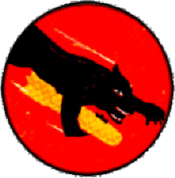
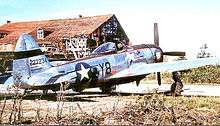
- Constituted 621st Bombardment Squadron (Dive) on 25 Jan 1943.
- Activated on 4 Feb 1943
- Re-designated: 507th Fighter-Bomber Squadron on 10 August 1943
- Re-designated: 507th Fighter Squadron on 30 May 1944
- Inactivated on 9 Nov 1945
- Re-designated 188th Fighter Squadron, and allotted to New Mexico ANG, on 24 May 1946
- Received federal recognition and activated on 7 July 1947
- Federalized and ordered to active service on: 1 February 1951
- Re-designated: 188th Fighter-Bomber Squadron, 1 February 1951
- Relieved from active duty and returned to New Mexico State Control: 11 September 1952
- Re-designated: 188th Tactical Fighter Squadron, 1 April 1964
- Federalized and ordered to active service on: 26 January 1968
- Relieved from active duty and returned to New Mexico State Control: 4 June 1969
- Re-designated: 188th Fighter Squadron, 16 March 1992
- Re-designated 188th Rescue Squadron, 1 January 2013
Assignments
- 404th Bombardment (later Fighter-Bomber; Fighter) Group, 4 February 1943 – 9 November 1945
- 86th Fighter Wing, 7 July 1947
- 140th Fighter Group, 1 November 1950
- 1st Fighter-Interceptor Group, 1 February 1951
- 4705th Defense Wing, 6 February 1952
- 27th Air Division, 1 March 1952
- 140th Fighter-Bomber Group, 11 September 1952 – 1 January 1953
- 140th Fighter-Bomber Group (later 140th Fighter-Interceptor Group), 1 January 1953
- 150th Fighter Group (Air Defense) (later 150th Tactical Fighter Group), 1 July 1957
- 31st Tactical Fighter Wing, 26 January 1968
- 150th Tactical Fighter Group]] (later 150th Fighter Group), 4 June 1969
- 150th Operations Group, 1 October 1995 – Present
Stations
|
|
New Mexico Air National Guard deployments
|
|
Aircraft
|
|
References
![]() This article incorporates public domain material from the Air Force Historical Research Agency website http://www.afhra.af.mil/.
This article incorporates public domain material from the Air Force Historical Research Agency website http://www.afhra.af.mil/.
- A Handbook of Aerospace Defense Organization 1946 – 1980, by Lloyd H. Cornett and Mildred W. Johnson, Office of History, Aerospace Defense Center, Peterson Air Force Base, Colorado
- Maurer, Maurer. Combat Squadrons of the Air Force: World War II. Maxwell Air Force Base, Alabama: Office of Air Force History, 1982.
- Kirtland AFB Fact Sheet
- GlobalSecurity.org
- Rogers, B. (2006). United States Air Force Unit Designations Since 1978. ISBN 1-85780-197-0

